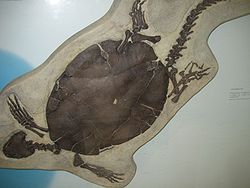| Paracryptodires Temporal range: | |
|---|---|
 | |
| Chisternon undatum | |
 | |
| Dorsetochelys skull | |
| Scientific classification | |
| Domain: | Eukaryota |
| Kingdom: | Animalia |
| Phylum: | Chordata |
| Class: | Reptilia |
| Clade: | Pantestudines |
| Clade: | Testudinata |
| Clade: | Perichelydia |
| Clade: | † Paracryptodira Gaffney, 1975 |
| Subtaxa | |
See text | |
| Synonyms | |
Pleurosternoidea | |
Paracryptodira is an extinct group of reptiles in the clade Testudinata (which contains modern turtles and their extinct relatives), known from the Jurassic to Paleogene of North America and Europe. Initially treated as a suborder sister to Cryptodira, [1] they were then thought to be a very primitive lineage inside the Cryptodira according to the most common use of the latter taxon. [2] They are now often regarded as late-diverging stem-turtles, lying outside the clade formed by Cryptodira and Pleurodira. [3] [4] [5] [6] Paracryptodires are divided into three main groups, Compsemydidae, known from the Late Jurassic to Paleocene of North America and Europe, Pleurosternidae, known from the Late Jurassic to Early Cretaceous of North America and Europe, and Baenidae, known from the Early Cretaceous to Eocene of North America. The latter two groups are more closely related to each other than to Compsemys, forming the clade Baenoidea.


